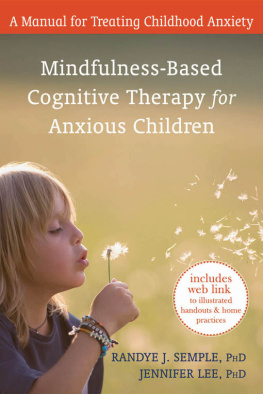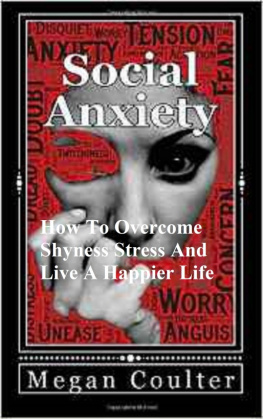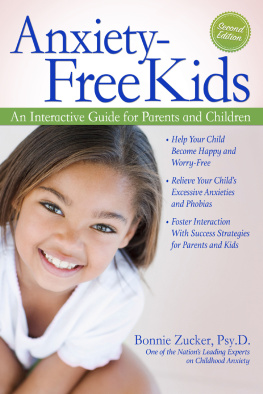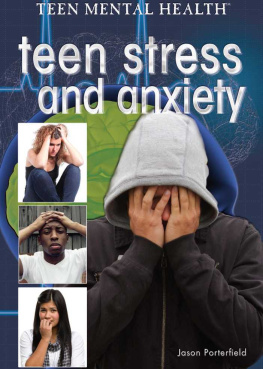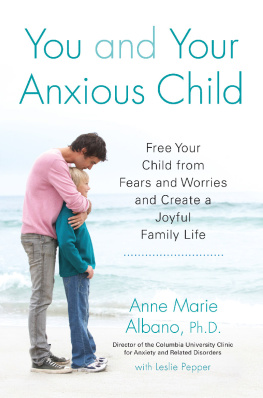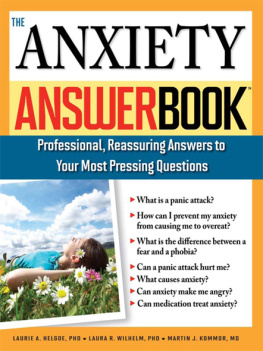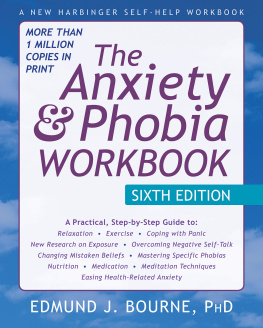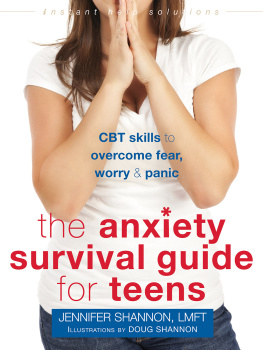Calming Your Anxious Child
Calming Your Anxious Child
Words to Say and Things to Do
Kathleen Trainor, PsyD

Note to the reader: This book is not meant to substitute for medical care of children with anxiety, and treatment should not be based solely on its contents. Instead, treatment must be developed in a dialogue between the individual and his or her physician. This book has been written to help with that dialogue.
Drug dosage: The author and publisher have made reasonable efforts to determine that the selection of drugs discussed in this text conform to the practices of the general medical community. The medications described do not necessarily have specific approval by the U.S. Food and Drug Administration for use in the diseases for which they are recommended. In view of ongoing research, changes in governmental regulation, and the constant flow of information relating to drug therapy and drug reactions, the reader is urged to check the package insert of each drug for any change in indications and dosage and for warnings and precautions. This is particularly important when the recommended agent is a new and/or infrequently used drug.
2016 Kathleen Trainor
All rights reserved. Published 2016
Printed in the United States of America on acid-free paper
9 8 7 6 5 4 3 2 1
Johns Hopkins University Press
2715 North Charles Street
Baltimore, Maryland 21218-4363
www.press.jhu.edu
Library of Congress Cataloging-in-Publication Data
Trainor, Kathleen, 1955 author.
Calming your anxious child : words to say and things to do / Kathleen Trainor.
Description: Baltimore : Johns Hopkins University Press, 2016. | Includes
bibliographical references and index.
Identifiers: LCCN 2015034014| ISBN 9781421420097 (hardcover : alk. paper) |
ISBN 9781421420103 (pbk. : alk. paper) | ISBN 9781421420110 (electronic) |
ISBN 1421420090 (hardcover : alk. paper) | ISBN 1421420104 (pbk. : alk.
paper) | ISBN 1421420112 (electronic)
Subjects: LCSH: Anxiety in children--Popular works. | Anxiety
disorders--Treatment--Popular works. | Parent and child--Popular works.
Classification: LCC RJ506.A58 T73 2016 | DDC 618.92/8522--dc23 LC record available at http://lccn.loc.gov/2015034014
Special discounts are available for bulk purchases of this book. For more information, please contact Special Sales at 410-516-6936 or .
Johns Hopkins University Press uses environmentally friendly book materials, including recycled text paper that is composed of at least 30 percent post-consumer waste, whenever possible.
To all my patients, past and present,
who have been my greatest teachers.
To my children, Dagan, Brian,
and Kara, and my daughters-in
law, Lori and Liza, and my beautiful
grandchildren, Dallan, Nevan,
and Braden.
My family has provided my inspiration through
their endless love and support.
Contents

Prologue. Anxious about Anxiety:
Responding to a Call for Help
Chapter 1. Fighting Anxiety:
Applying CBT with a Step-by-Step Approach
Chapter 2. Stepping Up to the Challenge:
How the 7-Step TRAINOR Method Works
Chapter 3. Daytime, Bedtime, Worry, Worry:
Generalized Anxiety Disorder
Chapter 4. Silent Liza and Hidden Patrick:
Selective Mutism and Social Anxiety
Chapter 5. Where Are You, Mom and Dad?
Separation Anxiety
Chapter 6. Tap, Check, Count, Wash, Repeat:
Obsessive Compulsive Disorder (OCD)
Chapter 8. When Bad Things Happen to Good Kids:
Post-Traumatic Stress Disorder
Chapter 9. And Theres More:
Hair Pulling, Skin Picking, Tics, Picky Eating,
and the Like
Chapter 10. Easier Said Than Done:
When More Help Is Needed
Calming Your Anxious Child
Prologue

Anxious about Anxiety
Responding to a Call for Help
Anxiety among children and adolescents is now considered an epidemic, and its prevalence continues to increase dramatically. After thirty-plus years of treating thousands of patients as a social worker and a child psychologist, I am amazed by the current pervasiveness of anxiety-related disorders such as obsessive compulsive disorder, separation anxiety, post-traumatic stress disorder, phobias, and selective mutism.
Why are anxiety disorders so prevalent?
Theres no definitive answer, but I believe its a combination of nature and nurture influences. Looking at environmental factors, our society has changed dramatically, becoming much faster paced and more complex. And family life is now more hectic and challenging than ever. As a key dynamic today, technology has had positive effects in reducing stress in some ways, but it has raised it in many other ways.
Our world is an increasingly anxious place. We have experienced 9/11, subsequent terrorist attacks, a financial crash, unthinkable school violence, devastating natural disasters, accelerated drug abuse, school bullying, more academically high-pressured kids, dramatic racial divides, and much more general tribulation. In short, familial, social, technological, economic, natural, and political forces have all stressed us out to the maxbut these have also informed us about how to raise our kids and manage stress.
Certainly, we have advanced in diagnosing and treating anxiety, although most anxious kids receive noor inadequatetreatment. Many families have been frustrated because various forms of therapy, however well meaning, and medication have not worked.
Family functioning is deeply affected when a child experiences anxiety. Parents are usually not prepared to help their anxious child, and dealing with an anxious child can be confusing. Parents may feel desperate as they search for effective guidance and support.
An Answer
The good news is that cognitive behavioral therapy (CBT) is an extremely useful approach for identifying and managing anxious thoughts and feelings. Through a family approach based on CBT (explored in depth in the books first chapter), parents and their children can learn strategies together, creating teamwork and strengthening family bonds.
This book describes a proven approachcognitive behavioral therapyto help anxious kids while actively engaging parents in the process. Other books effectively address some important issues, but none presents a behaviorally grounded how-to strategy to confront these problems. Accordingly, with so many families crying out for help, I felt compelled to construct the CBT-based 7-Step TRAINOR Method as a simple and pragmatic way to find solutions.
This book puts the TRAINOR Method to work. It is written primarily for parents, to help them learn more about anxiety disorders and symptoms of child anxiety. It also gives a voice to these anxious children, who are often misunderstood. Families and mental health and related professionals all will find this approach beneficial.
The children and teenagers I have treated differ in many respects, but children with anxiety can all benefit from many common strategies and lessons learned from the step-by-step TRAINOR approach. These strategies are mapped out in the book through case studies based on my interactions with real patients and parents, though in some instances I provide a composite view of the sessions in an attempt to be more comprehensive and informative for readers. In most chapters I outline my meetings with parents and then with the kids; sometimes I see them separately and sometimes as a group, starting with a younger childs experience and continuing with an adolescents case study. I describe the initial challenges, the strategy, and the results.
Next page

